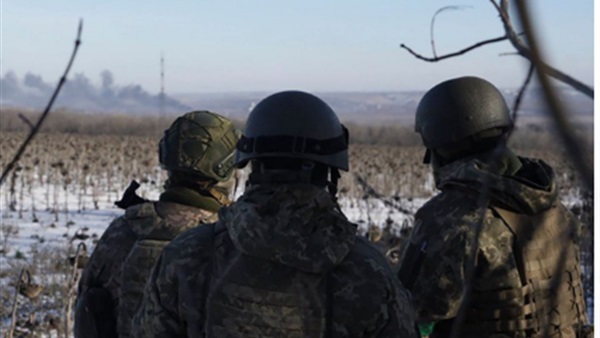Russia Claims Success in Ukraine’s Soledar, Its First Advance in Months

Russia claimed Wednesday its first significant success in
Ukraine since July, seizing most of the eastern town of Soledar after weeks of
heavy fighting led by the Wagner private military company.
Wagner’s owner, Yevgeny Prigozhin, said that, while the
entire territory of the town is under his fighters’ control, street battles
with the encircled remainder of Ukrainian forces are continuing in the downtown
area.
Ukrainian officials acknowledged Wagner’s recent advances in
Soledar, a resort town of salt mines with a prewar population of 10,000 people,
but denied that it had fallen.
“Soledar is not under the control of the Russian Federation,
our troops are not encircled, they continue combat, and we retain the ability
to supply them with weapons and provisions,” Col. Serhiy Cherevatyi of the
Ukrainian military’s Eastern Command said Wednesday. He declined to comment on
how much of Soledar remains in Ukrainian hands.
Kremlin spokesman Dmitry Peskov told reporters on Wednesday
to wait for official statements on the situation in Soledar.
“Let’s not rush,” Mr. Peskov said. “There is a positive
momentum of advancement there, but military success will be achieved when we
meet the goals set by the commander-in-chief,” he said, referring to Russian
President Vladimir Putin.
Russian advances in Soledar imperil Ukraine’s ability to
defend the nearby city of Bakhmut, which Wagner’s troops have been storming for
the past six months. A much bigger city and a gateway to the
Ukrainian-controlled half of the Donetsk region claimed by Russia, Bakhmut has
become a symbol of Ukrainian resistance in the war—and the conflict’s main battlefield
in recent weeks.
Ukrainian President Volodymyr Zelensky visited front-line
troops in Bakhmut just before flying to the U.S. last month, presenting a flag
signed by these soldiers to the U.S. Congress.
Wagner, which has grown to a force of some 50,000 men after
recruiting inmates throughout Russia’s prison system, seeks to portray itself
as the only Russian unit capable of offensive operations. Mr. Prigozhin, a
confidant of Mr. Putin, said in his message from Soledar that no regular
Russian troops were involved in battles there.
The Russian Ministry of Defense disputed that. Russian VDV
airborne troops were blocking Soledar from the north and the south, the Russian
air force was striking Ukrainian positions in the area and other Russian units
were fighting inside the town, it said.
Mr. Prigozhin and another warlord with a de facto private
army, Chechen leader Ramzan Kadyrov, have repeatedly criticized the leadership
of the Russian military as incompetent after Moscow lost large parts of the
Kharkiv, Donetsk and Kherson regions to Ukrainian offensives in September,
October and November. The last time Russia made gains in the war was the
seizure of the cities of Severodonetsk and Lysychansk, an operation where
Wagner played a major role, in late June and early July.
As the power struggle between Mr. Prigozhin and the Russian
defense establishment burst into the open, Mr. Putin has so far stood by his
defense minister, Sergei Shoigu, and defense general staff chief, Gen. Valery
Gerasimov. On Tuesday, Russia’s Ministry of Defense promoted Col. Gen.
Alexander Lapin, whom Messrs. Prigozhin and Kadyrov demanded to be punished for
Russian defeats in Kharkiv, to chief of staff of Russian Land Forces.
Wagner has transformed itself over the past 11 months from a
relatively small elite force that sent mercenaries to Syria and Africa to a
multitiered corps-size formation. Highly skilled veterans still command Wagner
units and provide artillery and air support. The storming of Ukrainian
positions is usually carried out by convicts, who are executed for desertion or
cowardice, but have been promised a pardon and a possibility to return home
should they survive six months in Ukraine. Mr. Prigozhin this month released
the first batch of a few dozen such survivors, many of them missing limbs.
“The enemy pays no attention to huge losses of its personnel
and continues the active assault. The approaches to our positions are simply
littered with the bodies of the adversary’s dead soldiers,” said Ukraine’s
deputy defense minister, Hanna Malyar.
Ukraine, however, is also taking high casualties on the
Bakhmut-Soledar front, quickly depleting the strength of several brigades sent
there as reinforcements in the past month.
In May and June, Ukraine made a similar stand in nearby Severodonetsk
and Lysychansk, grinding down Russian forces in heavy street battles before
eventually retreating to escape encirclement. That neutralized, for a while,
Russia’s offensive abilities.
At the time, however, Russia was mostly waging the war with
professional contract troops, and suffered from severe manpower shortages. Mr.
Putin’s October mobilization of 300,000 reservists, coupled with Wagner’s
prison recruitment drive that started in earnest in August, have changed the
arithmetic of attrition to be in Russia’s favor. Mr. Prigozhin has said that
his goal in the Bakhmut area isn’t so much to seize the city itself as to
destroy Ukraine’s most combat-capable forces.
Western—and some Ukrainian—officials, soldiers and analysts
increasingly worry that Kyiv has allowed itself to be sucked into the battle
for Bakhmut on Russian terms, losing the forces it needs for a planned spring
offensive as it stubbornly clings to a town of limited strategic relevance.
Some of them say that it would make sense to retreat to a new defensive line on
the heights west of Bakhmut while such a pullback can still be organized in a
coordinated fashion, preserving the Ukrainian military’s combat strength.
“It’s not me, it’s King Leonidas
who figured out that you should fight the enemy on the terrain that is
advantageous to you,” said one Ukrainian commander in Bakhmut, referring to the
ruler of Sparta who battled the Persian Empire at Thermopylae. “So far, the
exchange rate of trading our lives for theirs favors the Russians. If this goes
on like this, we could run out.”







